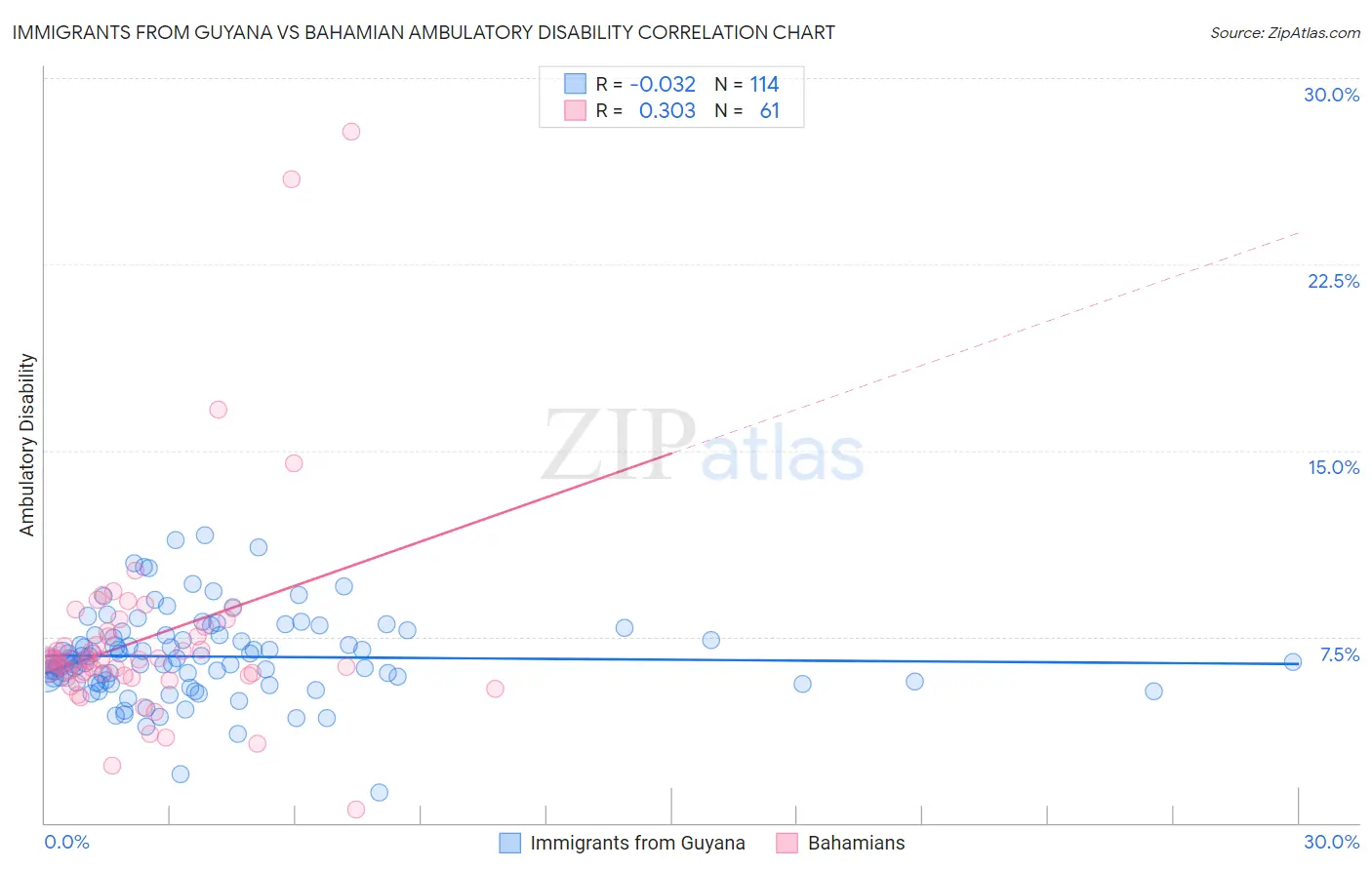Immigrants from Guyana vs Bahamian Ambulatory Disability
COMPARE
Immigrants from Guyana
Bahamian
Ambulatory Disability
Ambulatory Disability Comparison
Immigrants from Guyana
Bahamians
6.7%
AMBULATORY DISABILITY
0.1/ 100
METRIC RATING
275th/ 347
METRIC RANK
6.6%
AMBULATORY DISABILITY
0.2/ 100
METRIC RATING
265th/ 347
METRIC RANK
Immigrants from Guyana vs Bahamian Ambulatory Disability Correlation Chart
The statistical analysis conducted on geographies consisting of 183,703,785 people shows no correlation between the proportion of Immigrants from Guyana and percentage of population with ambulatory disability in the United States with a correlation coefficient (R) of -0.032 and weighted average of 6.7%. Similarly, the statistical analysis conducted on geographies consisting of 112,670,822 people shows a mild positive correlation between the proportion of Bahamians and percentage of population with ambulatory disability in the United States with a correlation coefficient (R) of 0.303 and weighted average of 6.6%, a difference of 1.5%.

Ambulatory Disability Correlation Summary
| Measurement | Immigrants from Guyana | Bahamian |
| Minimum | 1.2% | 0.55% |
| Maximum | 11.6% | 27.8% |
| Range | 10.4% | 27.3% |
| Mean | 6.7% | 7.4% |
| Median | 6.5% | 6.6% |
| Interquartile 25% (IQ1) | 5.7% | 5.9% |
| Interquartile 75% (IQ3) | 7.6% | 7.8% |
| Interquartile Range (IQR) | 1.9% | 1.9% |
| Standard Deviation (Sample) | 1.7% | 4.3% |
| Standard Deviation (Population) | 1.7% | 4.3% |
Demographics Similar to Immigrants from Guyana and Bahamians by Ambulatory Disability
In terms of ambulatory disability, the demographic groups most similar to Immigrants from Guyana are Celtic (6.7%, a difference of 0.030%), Sioux (6.7%, a difference of 0.060%), Jamaican (6.7%, a difference of 0.11%), Immigrants from West Indies (6.7%, a difference of 0.18%), and White/Caucasian (6.7%, a difference of 0.31%). Similarly, the demographic groups most similar to Bahamians are Nepalese (6.6%, a difference of 0.060%), Guyanese (6.6%, a difference of 0.12%), Trinidadian and Tobagonian (6.6%, a difference of 0.25%), Spanish (6.6%, a difference of 0.26%), and Hmong (6.6%, a difference of 0.46%).
| Demographics | Rating | Rank | Ambulatory Disability |
| Immigrants | Belize | 0.4 /100 | #260 | Tragic 6.6% |
| Irish | 0.4 /100 | #261 | Tragic 6.6% |
| English | 0.4 /100 | #262 | Tragic 6.6% |
| Hmong | 0.3 /100 | #263 | Tragic 6.6% |
| Nepalese | 0.2 /100 | #264 | Tragic 6.6% |
| Bahamians | 0.2 /100 | #265 | Tragic 6.6% |
| Guyanese | 0.2 /100 | #266 | Tragic 6.6% |
| Trinidadians and Tobagonians | 0.2 /100 | #267 | Tragic 6.6% |
| Spanish | 0.2 /100 | #268 | Tragic 6.6% |
| French | 0.1 /100 | #269 | Tragic 6.6% |
| Slovaks | 0.1 /100 | #270 | Tragic 6.7% |
| Immigrants | Trinidad and Tobago | 0.1 /100 | #271 | Tragic 6.7% |
| French Canadians | 0.1 /100 | #272 | Tragic 6.7% |
| Whites/Caucasians | 0.1 /100 | #273 | Tragic 6.7% |
| Sioux | 0.1 /100 | #274 | Tragic 6.7% |
| Immigrants | Guyana | 0.1 /100 | #275 | Tragic 6.7% |
| Celtics | 0.1 /100 | #276 | Tragic 6.7% |
| Jamaicans | 0.1 /100 | #277 | Tragic 6.7% |
| Immigrants | West Indies | 0.1 /100 | #278 | Tragic 6.7% |
| Immigrants | Caribbean | 0.0 /100 | #279 | Tragic 6.7% |
| Pennsylvania Germans | 0.0 /100 | #280 | Tragic 6.8% |